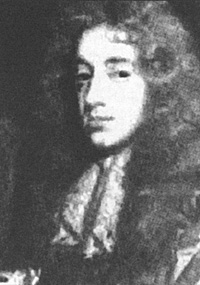 Wilmot (1612-58), was the younger son of 1st Viscount Wilmot, an Irish lord (who died in 1644). He served five years on the Continent in the Dutch Army (1635-40), and was with two other future Royalist commanders, Lord Goring and Sir Charles Lucas, at the siege of Breda in 1637.
Wilmot (1612-58), was the younger son of 1st Viscount Wilmot, an Irish lord (who died in 1644). He served five years on the Continent in the Dutch Army (1635-40), and was with two other future Royalist commanders, Lord Goring and Sir Charles Lucas, at the siege of Breda in 1637.
Wilmot commanded the cavalry of King Charles I during the Bishop's Wars (163940). At the battle of Newburn (28 August 1640), he gallantly tried to lead a charge against the advancing Scottish infantry, but his raw, undisciplined troopers were routed.
He was elected MP (Member of Parliament) for Tamworth in the Long Parliament 1640. Wilmot was one of the "militant group" of Royalists who attended Queen Henrietta Maria. He was expelled from Parliament in December 1641, for alleged complicity in the Second Army Plot, in which a group of Royalist officers was suspected of plotting to seize the Tower and occupy the City of London in the King's name.
Appointed Commissary-General of Horse in the King's Army in 1642, his first action was with Prince Rupert at the battle of Powick Bridge (23 September 1642). He was raised to the peerage as Lord Wilmot of Adderbury, and rode with Prince Maurice and Sir John Byron to relieve Lord Hopton's battered army, defeating Sir William Waller at the battle of Roundway Down (13 July 1643), where he distinguished himself.
His cavalry were scattered by Sir William Waller's at the battle of Cheriton (29 March 1644). He commanded the cavalry at the battle of Cropredy Bridge (29 July 1644) where he was wounded and briefly taken prisoner. In August 1644, Wilmot secretly attempted to negotiate a treaty with the Earl of Essex. When this came to light he was arrested at the head of his own troopers and dismissed from his command as Lt.-General of Horse of the King's Army (a most inglorious turn of events!) However, Wilmot was popular with his men, particularly with the "Old Horse", his elite cavalry brigade. His arrest resulted in a near-mutiny of a majority of the veteran horse of the King's Army. Rather than have him courtmartialed, the King decided to send Wilmot into exile along with Lord Percy, who was also implicated in the conspiracy. He went to France where he proceeded to work his way back into favor with Queen Henrietta Maria.
Finding favor with Charles 11, Wilmot accompanied him on his expedition to Scotland in 1650 and the subsequent invasion of England 1651 during the Third Civil War. He was with Charles II at the battle of Worcester (3 September 1651). After the defeat he accompanied Charles II on his six-week escape adventure, finally succeeding in evading capture and escaping to the Continent (France) in October 1651.
Wilmot became one of Charles' closest friends during his exile and was created Earl of Rochester (13 December 1652) for his military services to him during his exile under the Commonwealth period. He was sent to England in 1655, to command an uprising planned by the Royalist conspirators of the "Sealed Knot". The plan failed ignominiously with Penruddock's Uprising in March. Wilmot was fortunate to escape back to the Continent. In 1657 he commanded the English Royalist regiment that fought for Spain in the Anglo-Spanish War and died of fever on campaign at Sluys in Flanders, March 1658, just two years before the Restoration. No doubt that Wilmot, a gallant and brave, yet a hard-drinking Royalist from Anglo-Irish stock, would have enjoyed the Restoration with Charles II, and been so rewarded by the King.
Back to MWAN # 131 Table of Contents
Back to MWAN List of Issues
Back to MagWeb Magazine List
© Copyright 2004 Legio X
This article appears in MagWeb.com (Magazine Web) on the Internet World Wide Web.
Other articles from military history and related magazines are available at http://www.magweb.com